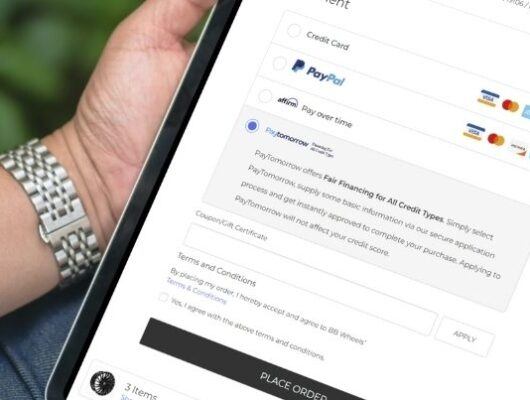Meeting the needs of online consumers goes beyond providing the right product at the right price. As an online merchant, you must ensure every visitor can effectively access and use your online store. This obligation falls under the broad umbrella of web accessibility, a term encompassing features that collectively create an environment where everyone, regardless of their abilities, can navigate, interact with, and benefit from your ecommerce website.
As accessibility-related lawsuits targeting ecommerce businesses continue to rise, we’ll explore the concept of digital accessibility, potential legal implications for online merchants, and business benefits of maintaining an accessible website. We’ll also address a common question from ecommerce merchants: Can accessibility apps protect against legal challenges? Let’s get started.
Understanding ADA Compliance and Why It Matters for Ecommerce Merchants
The Americans with Disabilities Act is a federal law that prohibits discrimination against people with disabilities. It requires all businesses open to the public, including online companies, to ensure their products and services are accessible to all.
While not a law itself, the Web Content Accessibility Guidelines (WCAG) is a set of standards developed by the World Wide Web Consortium (W3C) to make web content more accessible. The Department of Justice and federal courts have referenced the WCAG 2.1 Level AA as the de facto standard for web accessibility compliance.
Ecommerce merchants are facing a surge in accessibility-related lawsuits, with 84% of such legal actions targeting online businesses. Notably, these lawsuits aren’t limited to large corporations, as companies with annual revenue below $25 million represent over 77% of the cases. While web accessibility enforcement is a complex and evolving area of law, all businesses must comply with accessibility standards and address accessibility issues proactively, as discussed further below.

Common Ecommerce Accessibility Issues and How to Improve Them
Web accessibility is about removing barriers that can prevent disabled individuals from accessing and enjoying your online store. Below are a few common accessibility issues and our process for helping our clients create a more accessible web experience for their users.
- Issues with Color Schemes and Color Contrast
- Inconsistent/Poorly Organized Headers Formatting and Structure
- Insufficient Keyboard Navigation Support
- Missing, Incomplete, or Incorrectly Labeled Form Fields
- Missing Image Alt Text
WCAG 2.1 has three “levels” or tiers of conformance for success criteria, ranging from Level A (lowest) to Level AAA (highest).
BigCommerce Web Accessibility Remediation Process
While ecommerce merchants should aim to be as accessible as possible, reaching higher tiers of conformance depends largely on what their business can reasonably provide/facilitate. Our experienced certified BigCommerce developers implement solutions to help your site meet WCAG 2.1 standards through a comprehensive, iterative process.
Through our Web Accessibility Remediation Process, our experts will:
- Perform an audit to assess your site’s current level of accessibility
- Prioritize issues by level of importance/impact
- Remediate accessibility issues
- Record improvements and repeat the process monthly
Some of the tools we use include:
- aXe Chrome Extension
- Accessibility Insights for Web Chrome Extension
- WCAG 2.1 online tool
- Google Lighthouse
The Business Case for Investing in Web Accessibility
Embracing web accessibility is not just about meeting legal requirements; it’s a strategic move that yields significant benefits for your online store. Here are a few compelling reasons why digital accessibility should be a top priority for your business.
- Enhancements for Disabled Users Means Benefits for All. When you design your ecommerce website with accessibility in mind, you’re not just making it usable for individuals with disabilities; you’re creating a more user-friendly environment for all of your visitors. Features such as clear navigation, well-structured content, and easily readable text benefit everyone, leading to higher customer satisfaction and increased conversions.
- Increased Market Share and Diverse Customer Base: Prioritizing web accessibility not only enhances the user experience but also broadens your market reach. By catering to users with disabilities, you tap into a diverse customer base that might otherwise be overlooked. This inclusivity can lead to increased brand loyalty and expanded business opportunities.
- SEO Success Through Accessibility. By ensuring your website is accessible, you’re essentially optimizing it for search engines as well. Search engine crawlers can more effectively index and rank your content, potentially leading to higher organic search traffic and improved visibility.

Do Accessibility Apps Protect Against Accessibility Issues?
In the quest to make websites accessible, many online merchants turn to accessibility plugins or apps as a quick and seemingly convenient solution. These tools often promise to identify and fix accessibility issues with minimal effort, but are they the silver bullet for ensuring compliance and warding off potential lawsuits?
While these tools can catch some common issues, they may miss unique or complex accessibility challenges specific to your online store. Each website is distinct, and the accessibility needs of users can vary widely. Relying solely on automated apps can create a false sense of security, leaving you vulnerable to overlooked issues.
Professional accessibility remediation is more than just a checkbox exercise; it’s a strategic approach to ensuring that your website is genuinely accessible to all users. By engaging digital accessibility experts, you benefit from a human-centered perspective that goes beyond automated scans.
Partner with IntuitSolutions to Assess and Improve Your Digital Accessibility on BigCommerce
By prioritizing accessibility, you create a win-win scenario: a website that welcomes all users, impresses search engines, and helps safeguard your business from legal pitfalls.
At IntuitSolutions, we are expert BigCommerce developers with expertise in helping BigCommerce merchants assess and enhance their accessibility. If you’re ready to discover your specific accessibility requirements, evaluate your website’s current status, and receive expert guidance in the remediation process, we’re here to assist you.
Important Notice: This article is not a substitute for legal advice. To ensure full compliance with accessibility regulations and protect your online business, please consult with legal experts.








